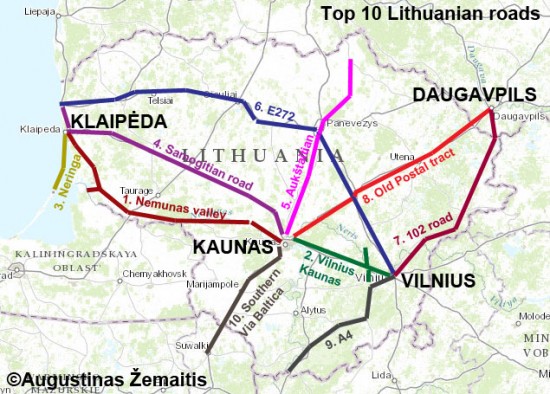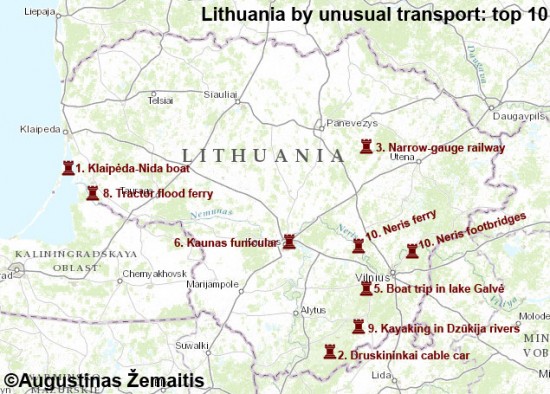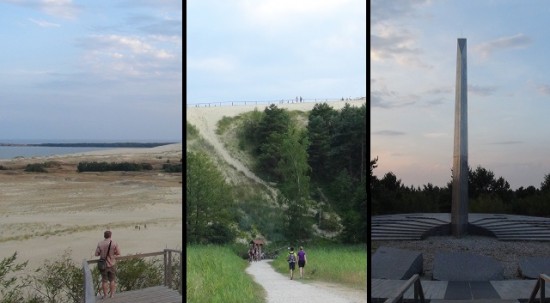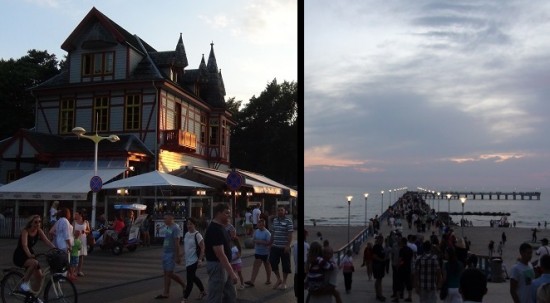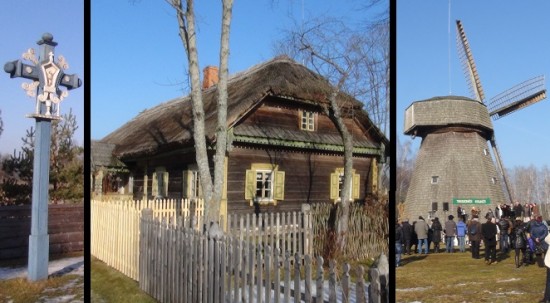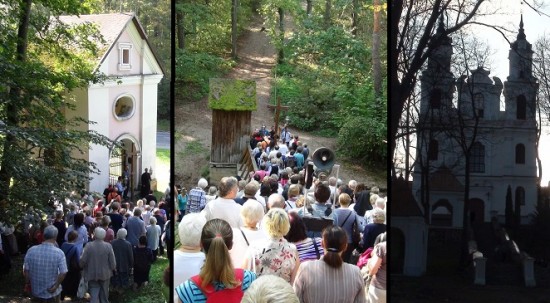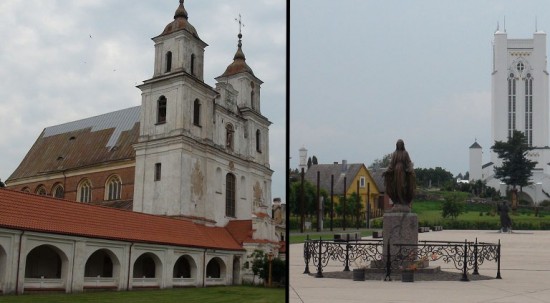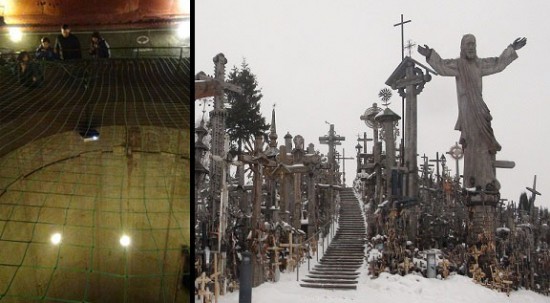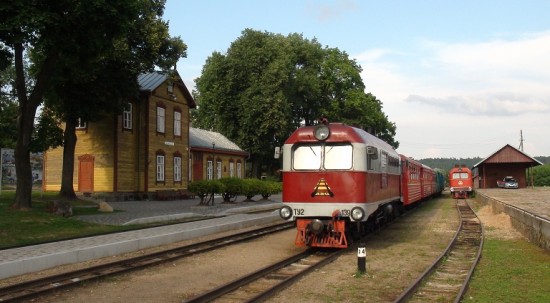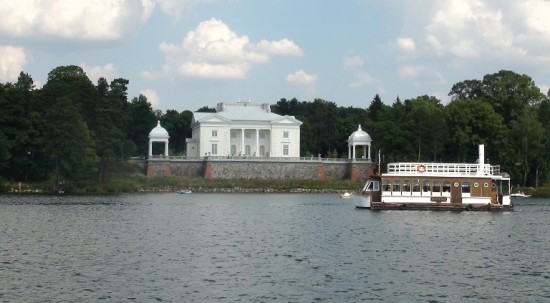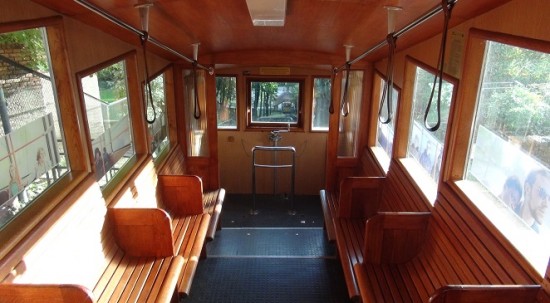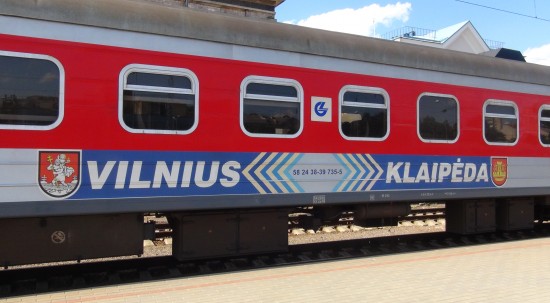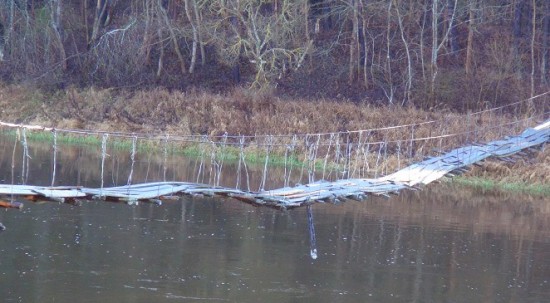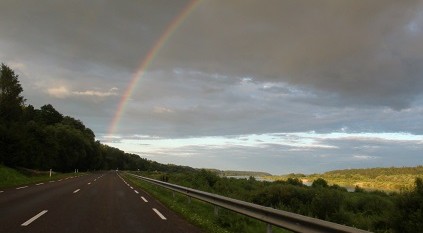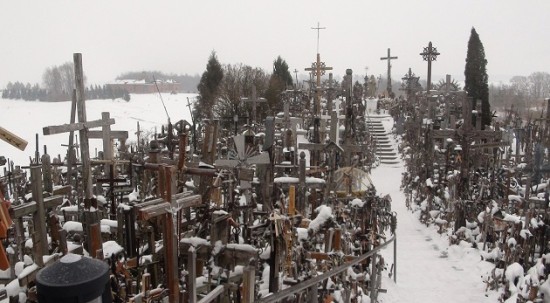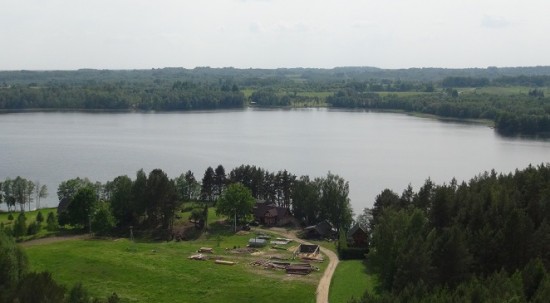Lithuania by mode of transport
If you have your preferred form of transportation while in Lithuania (that is, walking, biking, driving or public transport), here our ideas for the best routes in each case:
*Lithuania on bike. 10 most rewarding bike tours.
*Lithuania on foot. 10 short walks/hikes with views over interesting architecture and natural wonders.
*Lithuania by car. 10 best road journeys in Lithuania.
*Lithuania by unusual transport. There are more options in Lithuania than either your own foot, bike, car or a bus, as this top 10 clearly demonstrates.
Lithuania on Foot: Top 10 Walks/Hikes
These are 10 best locations to see Lithuania on foot: urban and natural paths several kilometers in length that pass by many interesting, fun or atmospheric locations.
All the walks here may be done in 1-2 hours, but most have enough sights, activities, and pretty views to easily take half a day if done at a more leisurely and inquisitive pace. They are either relatively straight or well marked.
1.Route of the Monarchs in Vilnius. Discover Old Vilnius the way merchants, pilgrims, and nobles of days gone by used to see it. Enter through the Gate of Dawn and go all the way to the upper castle that once guarded the city, enjoying panoramas. This straight and simple walk passes by the key churches (eight in total) and secular buildings of Old Vilnius, including the City Hall and rebuilt Grand Dukes Palace. Distance: 2 km one way. Street names: Aušros Vartų, Didžioji, Pilies.
2.Parnidis dune in Nida. Witness some of Lithuania's most impressive (even if not typical) scenery by ascending Parnidis dune by a footpath from Nida resort and then descending it to freely roam on the massive sands of "Lithuanian Sahara". Sunrises and sunsets are especially impressive from the sundial-crowned top. Distance: 2 km one way.
3.Kaunas main street walk. Go back in time through the centuries of Kaunas city history by starting at the modern eastern end of Laisvės avenue and traversing the whole pedestrianised main street (known as Laisvės avenue in its 19th-20th centuries extension and Vilniaus street in its Medieval section). Initially, you'll see interwar "temporary capital" and Russian fortress era buildings (New Town), then beyond the remnants of city wall you'll be greeted by the Old Town with numerous gothic buildings. Near the end of the walk, you'll enter City Hall (Rotušės) square with all the main churches of Kaunas. Continuing beyond it, you'll see Kaunas castle and the confluence of two Lithuania's mightiest rivers which gave birth to the city. Distance: 3,5 km one way.
4.Basanavičiaus street walk in Palanga. In summer evenings this pedestrianised resort avenue becomes the Lithuania's prime stroll, full of nightlife, restaurants, souvenir shops, funfairs and live outdoor gigs. Appropriately for Lithuania's prime seaside resort the street crosses the beach and continues into the sea (as the Sea Bridge). Summer weekends are the most lively. For the best experience, go towards the sea before sunset, then watch the sunset from the Sea Bridge and come back during dusk, joining the crowds and maybe eating and chilling out en-route. Distance: 1,5 km one way.
5.Smiltynė embankment and Klaipėda breakwater walk. Leisurely enjoy the Lithuanian coast on this pedestrian path, watching pre-WW1 villas, fisherman farmstead, written-off vessels, sea museum and views of the Klaipėda port on the opposite side of the lagoon. These are joined by furious seas and incoming cruise ships - if you come on the right time. Start at the Old Ferry (at Smiltynė) and move northwards to the end of a port breakwater. Distance: 3,5 km one way, with at least partial return on foot required.
6.Rumšiškės ethnographic museum walk. See a manicured version of 19th-century Lithuanian countryside at the Rumšiškės ethnographic museum, one of the Europe's largest open-air museums where farmsteads and other wooden buildings from all over Lithuania have been brought together. Distance: 5-7 km circle, depending on exact route.
7.Belmontas-Pūčkoriai rock exposure route (Vilnius suburbs). Experience the greenery of Vilnius city by following the Pūčkoriai footpath in one of two regional parks entirely within city limits. Starting and ending at an ex-mill transformed into a restaurant it has a 65 m tall rock exposure as its main draw. Distance: 2 km circle. Those who wish may additionally climb stairs up the exposure for nice views.
8.Gedimino Avenue walk in Vilnius New Town. Walk the entire traditional high street in Vilnius, laid in the 19th century and serving as Vilnius hub ever since. Parliament, government, many ministries, boutiques and elaborate 19th-century buildings will be en-route. The street is sometimes pedestrianized and used for temporary festivals and fairs. At the one end, Cathedral square is the traditional heart of Vilnius, while at the other end Independence square was the stage of 1991 anti-Soviet stand that contributed heavily to the demise of Soviet Union. Old Žvėrynas bridge continues into calm pre-WW1 Žvėrynas neighborhood. Distance: 2 km one way.
9.Vilnius Calvary via dolorosa (Vilnius suburbs). A destination for pilgrimage since 18th century this route seeks to faithfully recreate the final path of Jesus Christ in its length, height levels, and relative directions. It is lined by 35 chapels. Groups of pilgrims pray at each of them during special events but at other times you will have the path for yourself. Distance: 7 km.
10.Juniper valley walk. Walk watching the Nemunas river and Kaunas reservoir panoramas with junipers lining the semi-submerged valley. Distance: 1,3 km one way (with return likely needed).

Map of the top 10 locations to explore Lithuania on foot. ©Augustinas Žemaitis.
10 great roads of Lithuania for car travel
Lithuania may be a small country, but as its sights are evenly divided across its territory it offers some great road itineraries for travelling by car.
All roads mentioned here are 100-300 km in length with interesting sights and towns with amenities every 20-50 km. They are all tarred and begin/end at the key entry points of Lithuania (Vilnius, Kaunas, Klaipėda, Latvian and Polish borders). The end points of the roads meet up, allowing return by a different scenic route.
1.Panemunė (Nemunas Valley) Road (no. 141) is arguably the most scenic route in Lithuania, offering a longer alternative for a voyage between Kaunas and Klaipėda. Its Nemunas Valley section near Kaunas offers the top landscapes of Lithuania's largest river, dotted by castle-inspired palaces of 17th-19th-century nobility (Raudondvaris, Raudonė, Panemunė). Further to the west, the road enters Lithuania Minor region with its orderly once-Lutheran once-German-ruled townships (Šilutė is considered the region's capital). A brief detour will let you visit Nemunas Delta where the mighty river empties into the Curonian lagoon; the area is famous for annual floods, bird migration, and fishermen culture. Distance: 237 km, Kaunas-Klaipėda
2.Vilnius-Kaunas (Four capitals route) allows one to visit all four capitals of Lithuania, each breathing in different eras. Trakai with its castles are Medieval, Kernavė archeological site dates to prehistoric era while Kaunas served as capital in interwar period, getting an enviable selection of art deco, bauhaus and early modern architecture. Vilnius, the long-term Lithuanian capital, combines all the eras. Vilnius-Kaunas route is also the most popular car road in Lithuania. Distance: 100 km + ~60 km detours, Vilnius-Kaunas.
3.Neringa road (Smiltynė-Nida) is a scenic National Park forest road in Lithuania's Curonian Spit peninsula, accessible only by ferry (or via Russia). You may stop at numerous resort villages, hike paths on spectacular dunes as well as one of the Europe's largest cormorant colony. Distance: 50 km, Klaipėda-Nida (but return by the same road is required unless continuing to Russia - making it 100 km two-ways)
4.Samogitians Road (no. 196) linked Kaunas to Klaipėda in 1933, making the internal Samogitia and the seaside easily accessible. Once known as a fierce forested land that abandoned paganism as late as 1413, Samogitia is now famous for its Christian heritage. With detours one may visit Šiluva Virgin Mary Shrine (the top pilgrimage site in Lithuania) and pretty Tytuvėnai monastery. Further on Kražiai and Varniai (the historical capitals of Samogitia) stand, with their fading glory still visible in churches and other buildings larger and older than common in other Lithuanian towns of ~1000 inhabitants. Rietavas even further westwards was famous as the location of Lithuania's first power plant built by its enlightened dukes. Due to massive numbers of cars flocking to the seaside the Samogitian road was doubled by A1 highway in 1987 - both follow nearly the same route and offer the same detours (but A1 bypasses towns). A monument for Samogitian road stands at the exit from Kaunas, offering views of Vilijampolė district. Distance: 219 km + detours, Kaunas-Klaipėda
5.Aukštaitian Road (northern Via Baltica) (Kaunas-Biržai, A8/A10). Constructed in 1937-1940, Aukštaitian road was one of the two key road infrastructure projects of interwar Lithuania that connected temporary capital Kaunas with the hinterland by tarred roads (the other was Samogitian road). The Aukštaitian road is rich in a heritage of famous Radvila family which some 200-400 years ago literally owned some of the local towns and fought other noble families for dominance over Lithuania. Two of their key strongholds are Kėdainiai (famous for its pretty old town) and Biržai (famous for a 17th century Radvila fortress). Both areas have many churches of different denominations and Radvilas were known to support religious freedom. Lithuania's 5th largest city Panevėžys may lack comparable sights, but provides great opportunities for shopping, eating and accommodation. Nearly the whole Aukštaitian road has been designated a part of Via Baltica after the 1990s (the primary route between Warsaw, Kaunas, Riga, and Tallinn). Distance: 179 km, Kaunas-Biržai (Latvian border)
6.E272 route (Vilnius-Panevėžys-Šiauliai-Palanga) is the longer alternative to go from Vilnius to Lithuania's seaside. It passes by Lithuania's 4th and 5th largest cities (Šiauliai and Panevėžys), pretty towns of Ukmergė and Telšiai, the towns of Plungė and Kretinga (famous for their manors) before reaching the Lithuania's top seaside resort Palanga. Easy detours may be done to the Hill of Crosses and Samogitian National Park (with its Soviet nuclear missile lanch site). Distance: 361 km (of them 128 km four-lane highway), Vilnius-Palanga (near Latvian border).
7. 102 road (Vilnius-Zarasai-Daugavpils) traverses the multi-ethnic Eastern Lithuania, passing by Polish, Russian Old believer and Lithuanian villages. Key sights en-route are the Aukštatija National Park with its lakes and villages that changed little for centuries as well as Visaginas, a Russian-dominated Soviet-constructed nuclear power plant workers town. Minority heritage includes Old Believer church at Jurgėliškė and birthplace of Polish president Pilsudski. Distance: 164 km, Vilnius-Zarasai (Latvian border).
8.Old postal tract (Kaunas-Daugavpils, A6) was constructed as part of the all-important Saint Petersburg-Warsaw link. In 1836 it became the first Lithuania's road to be surfaced. As such, the road has considerable 19th-century heritage. Massive Russian fortresses adorn Kaunas and Daugavpils. Ukmergė has a lovely 19th century downtown while Zarasai has a fan-form town plan dating to the era (when it was named Novoaleksandrovsk after a czar). There are surviving horse change stations and other 19th-century road infrastructure along the route. Distance: 211 km, Kaunas-Daugavpils (Latvian border)
9. A4 road (Vilnius-Druskininkai) is the main Access to the Dzūkian forests. The old capital Trakai, Dzūkija national park with its forests and monasteries are visitable en-route. The route ends at Druskininkai, the recently revitalised 19th century spa resort. Distance: 128 km, Vilnius-Druskininkai.
10. Southern Via Baltica (Kaunas-Poland, A7) is the southern Lithuanian section of massive Warsaw-Kaunas-Riga-Tallinn route and the prime entrance to Lithuania from Poland. It passes by calm Sudovian towns (such as Marijampolė) which were the heartlands of Lithuanian national revival. They have little in particular to offer, but the atmosphere of agricultural Sudovia may be nice. Some of the area's loveliest places are located beyond the Polish border where the majority of people are still Lithuanian. For example, the Prussian-Yotvingian settlement. Distance: 123 km (Kaunas to Suwalki in Poland).
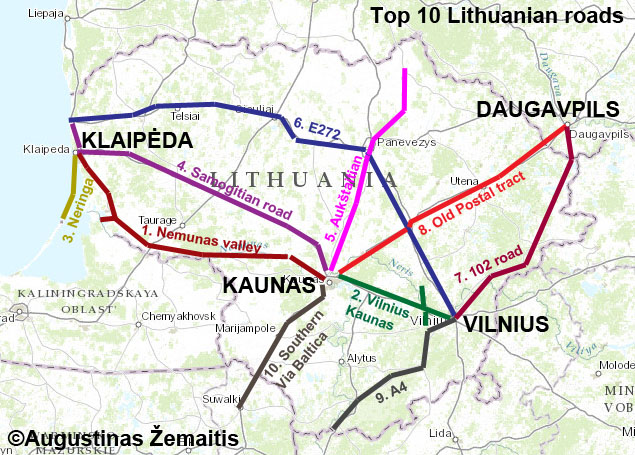
Map of top 10 tourist roads in Lithuania. ©Augustinas Žemaitis.
Lithuania by unusual transport: top 10 ideas
You may see Lithuania the way most people don't by using uncommon forms of transportation ranging from historic trains to scenic ships. Here are top 10 ideas:
1.See the Neringa dunes from the lagoon using the Klaipėda-Nida regular boat. The service may be more expensive than a bus, but it offers a unique opportunity to see the entire length of picturesque Neringa shoreline without hiring a boat. The vistas will include Nagliai reserve "dead dunes", pine forests, resort villages, fishermen boats, and lighthouses.
2.Ride the Lithuania's only cable car in Druskininkai. While Lithuania is an extremely flat country that sees limited snow, Druskininkai resort has built an indoor Alpine skiing track for local skiing enthusiasts. In order to complete the image of "mountain resort", a cable car connected downtown to the skiing track, offering great vistas of Dzūkija region forests and Nemunas river en-route.
3.Experience the Lithuanian railroad history in Aukštaitija narrow gauge railroad. Opened in 1899 and once ~400 km in length it slowly faded into obscurity, leaving it incredibly authentic. Many wooden stations are seemingly never renovated (complete with wooden external squat toilets), the rolling stock includes Soviet 1950s diesel locomotives and 1980s carriages (they look older than the date implies due to Soviet technologic backwardness). Closed in 2001 the railway was saved by enthusiasts who now offer trips from Anykščiai to nearby villages (lakeside Rubikiai and Troškūnai famous for a baroque church) every weekend day (May to October). The experience of slow countryside ride includes some reenactions of the era's railway traditions and explanations (Lithuanian only), while more could be learned at the Anykščiai station museum.
4.Silently glide over the Lithuanian cities in a hot air balloon. Ballooning is a popular hobby, with some claiming Lithuania leads the world in balloons-per-capita. There are few restrictions and every summer morning and evening the urban skies fill with these colorful lighter-than-air contraptions.
5.See the Trakai Island castle from every side by taking a Lake Galvė boat trip. Additionally, you will see Užutrakis manor in its prettiest and the peninsula castle from a unique side.
6.Follow the steps of interwar Kaunas residents: ascend the local hills in two funiculars. Originally built to help inhabitants of the hill districts to descend into valley downtown, they were now restored. Both top stations have great viewpoints nearby (a free one at Aleksotas and a paid church tower at Žaliakalnis). Funiculars are convenient even if you have a car: parking uphill is mostly free, so leaving your car there and descending by funicular may save you money. Žaliakalnis funicular operates every day while Aleksotas is Monday-to-Saturday.
7.Traverse the entire Lithuania by riding Vilnius-Klaipėda trains, Lithuania's longest passenger route. During the 4-4,5 hour trip, they stop at or near many famous locations: capital Vilnius, Kėdainiai historic town, Šiauliai (near Hill of Crosses), Telšiai, Plungė (famous for a manor and located next to Samogitian National Park), Kretinga (with easy access to Palanga resort) and Klaipėda. The frequency is 3-4 trains per day so it is the best to space out the journey over multiple days, hopping on-and-off en-route. Lithuanian railways may be less popular and slower than in many developed countries, but they still have some charm and more predictability (it is much easier to find rail timetables online than bus timetables).
8.Cross the flooded Minija-Rusnė road using the ferry tractor. A high clearance tractor uses a high-clearance trailer to move low clearance vehicles across what becomes a deep ford every springtime. Unique floodplain where farmsteads have been built on hills (which turn into inaccessible islands every spring) may also be explored.
9.Rent kayaks in Dzūkija rivers to enjoy the forested banks and pristine nature.
10.Use one of the numerous out-of-the-beaten-path weird crossings of the Neris river (second largest in Lithuania). The amateur-built rope footbridge at Strapa is so rickety that it may be hard to believe it is regularly used by villagers without collapsing. A similar rope bridge upriver near Buivydžiai is of better quality, but still with weight heavily limited. In Čiobiškis there is no bridge, so locals cross the river (with their cars) by a reaction ferry that reminds of a floating engine-less platform. Lastly, in Vilnius it is possible to cross Neris by a zipline.

Map of the top 10 ways to see Lithuania by unusual transportation. ©Augustinas Žemaitis.
Lithuania on Bike: Top 10 routes
For decades bicycle was regarded to be either a child's toy or a sports inventory in Lithuania. This changed in the 2000s when a new network of bicycle routes and rent agencies increased the popularity of cycling as a pastime. Here are some of the most rewarding 20-70 km routes in Lithuania that can be traveled on a bike.
Some of these routes are notable for good bicycle path infrastructure, others lack it but offer a possibility to see great sights every 10-20 km and the regular Lithuanian back-roads are not that crowded to seriously hamper bicycle Travel.
1.Ride the entire length of Lithuania's Curonian spit by a long bicycle path with many possible stops en-route for rest and coming in terms with nature. Main sights: Klaipėda Sea Museum, Juodkrantė resort, Juodkrantė cormorant colony, Nagliai dune reserve, Nida Parnidis dune. Distance: ~50 km.
2.Explore the out-of-the-beaten-path Vilnius. Vilnius has developed a good network of bicycle paths, making them a great form of transportation. Moreover, an automated bicycle rent system with many stations is both cheap and convenient. Vilnius Old Town is famous for its churches, nice old streets, and entertainment. However it is in reaching the sights further away where a bicycle truly excels, and the Suburbs of Vilnius have lots of interesting (although less well known) places.
3.Check the most famous stretch of Panemunė (Nemunas Valley) Road is dotted by castle-inspired palaces of 17th-19th-century nobility (Raudondvaris, Raudonė, Panemunė) and offers nice landscapes of Lithuania's top river. Distance: 70 km Kaunas to Skirsnemunė, or 40 km Vilkija to Skirsnemunė
4.Traverse the Lithuanian Baltic Sea coastline. A good bicycle-only path passes by the key locations of Seaside Klaipėda, Palanga, and Šventoji - historic resorts and fishing villages. Main sights: Giruliai resort, Karklė seaside cemetery, Olando Kepurė cliff, Palanga Botanical Park, Palanga Manor, Palanga Sea Bridge, Šventoji Pagan Shrine. Distance: ~50 km.
5.Ride Šiauliai-Hill of Crosses-Naisiai route. The road links Lithuania's fourth largest city with the Hill of Crosses, a breathtaking religious site where millions of crosses have been built by millions of pilgrims. Further on one may visit Naisiai village, a pagan alternative to the Hill of Crosses. Šiauliai itself is also famous for its bicycle manufacturing and has a bicycle museum. ~20 km, with 13 km just to the Hill of Crosses.
6.Explore the Samogitian National park on bike. Main sights: Plokštinė Soviet Nuclear Missile site (Cold War museum), Plateliai and Beržoras wooden churches, Orvidas farmstead.
7.Explore the Dzūkija National park on bike. Main sights: Marcinkonys village, Čepkeliai swamp, Ūla rock exposure, Liškiava monastery. Druskininkai resort and Grūtas park of Soviet sculptures are not far away.
8.Explore the Aukštaitija National park on bike. Main sights: Marcinkonys village, Čepkeliai swamp, Ūla rock exposure, Liškiava monastery. Druskininkai resort and Grūtas park of Soviet sculptures are not far away.
9.Ride the heartland of Samogitia. While this area may lack good bicycle paths, it offers a nice pacing of a journey as interesting towns are located every 10-30 km. Top sights are Šiluva Virgin Mary apparition site, Tytuvėnai monastery, the former regional centers Kražiai and Varniai as well as Rietavas. Total length: 75 km.
10.Explore the bicycle paths at Alytus, Lithuania's sixth largest city. They include an all-new bicycle-and-pedestrian bridge over Nemunas, which is the tallest bridge in Lithuania offering great views of the river.

Map of the top 10 bike routes in Lithuania. ©Augustinas Žemaitis.

